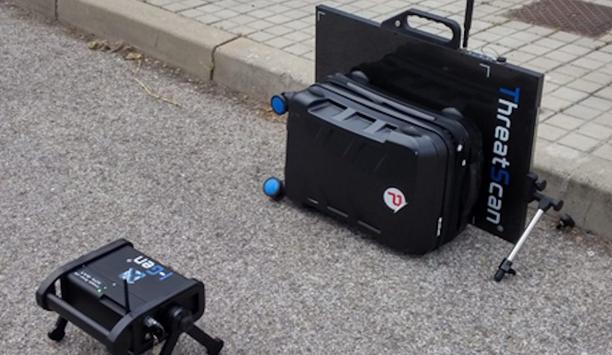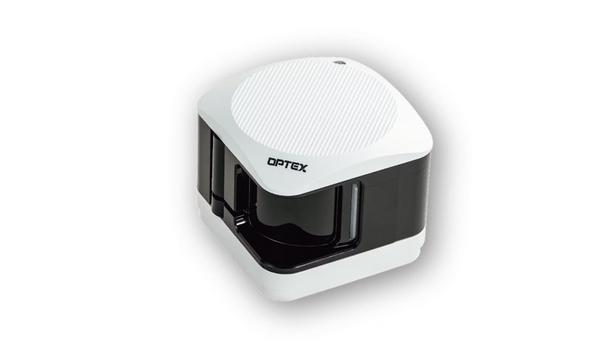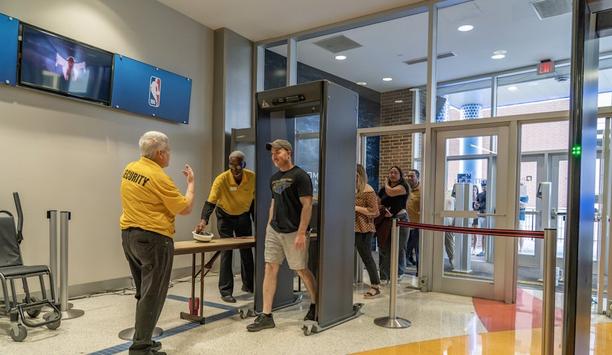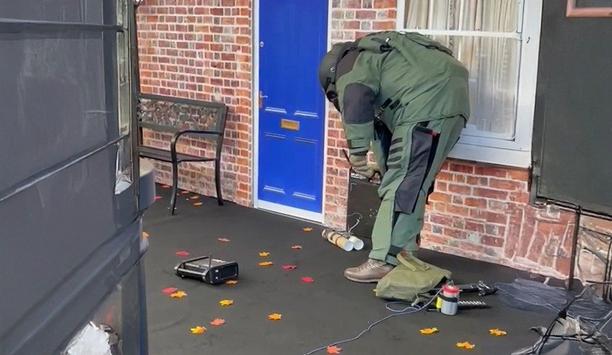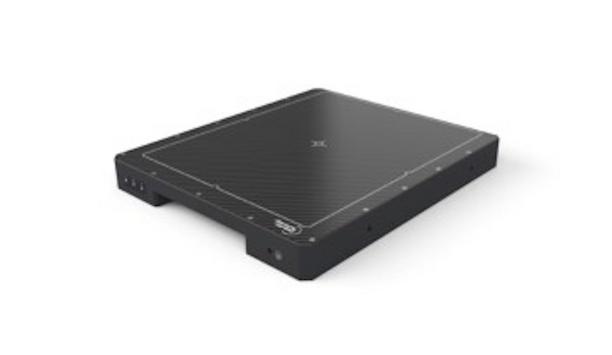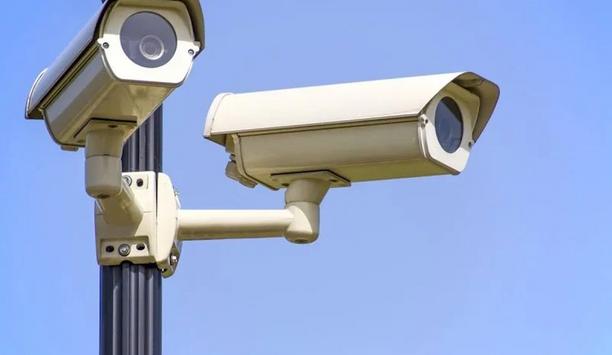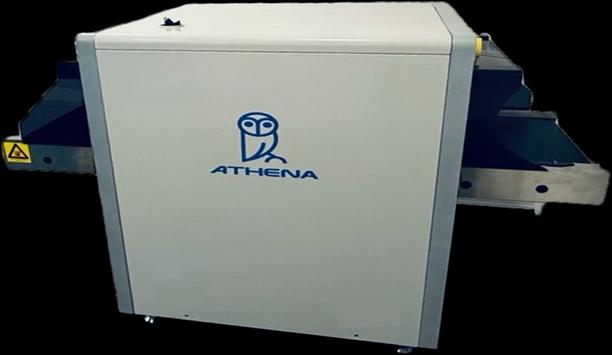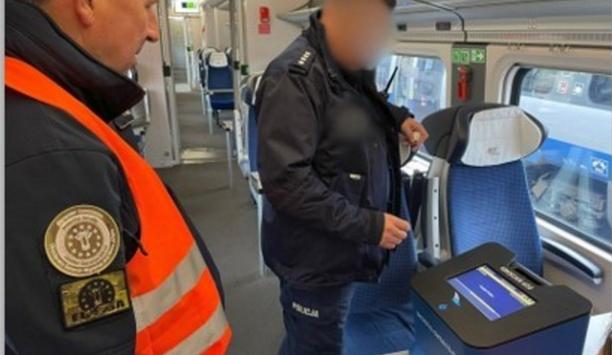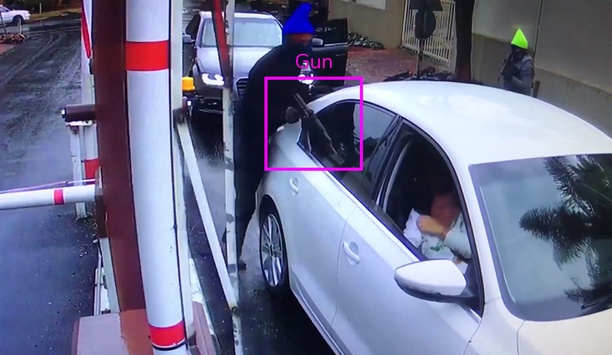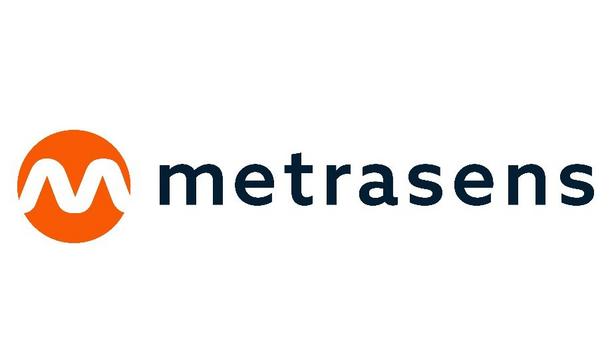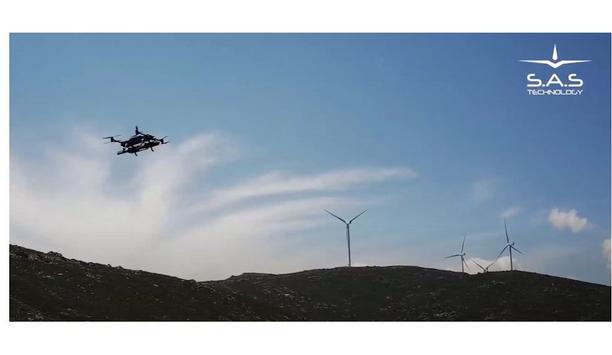Explosives detection
3DX-RAY, a pioneer in advanced X-ray imaging technology, is pleased to announce the successful acquisition of a significant double-digit unit contract with the esteemed Indian partner for the ThreatScan LS1 system. This innovative solution has been selected for its impressive size, ruggedness, and exceptional capability to efficiently handle Passive Infrared (PIR) devices activated by X-ray technology. EOD and security applications The ThreatScan LS1 is an advanced X-ray imaging system specif...
OPTEX, the renowned global sensor manufacturer, has launched the REDSCAN Lite LiDAR sensor, designed to provide extremely precise and ultra-fast, short-range detection across indoor high-security environments. As the latest addition to OPTEX’s award-winning REDSCAN LiDAR range, the REDSCAN Lite RLS-1010L has been specifically developed to provide total coverage and protect high-risk security zones and vulnerable, narrow indoor spaces that are difficult to protect with traditio...
Texas-based Garrett Metal Detectors announced that it has released new software for its premium walk-through metal detector, Paragon. This major update to Garrett’s leading-edge screening system includes several key refinements and new capabilities for the detector’s performance and operation, driven by the introduction of Garrett’s new, proprietary advanced AI security platform for metal detection using machine learning. Software update Garrett has identified five cor...
3DX-Ray announces a contract for the sale of further ThreatScan®-AS1 systems to a Middle Eastern Law Enforcement Agency. This sale is a follow-on order to multiple similar systems already in service with the agencies EOD and search teams. The 3DX-RAY ThreatScan®-AS1(ISC) is a robust amorphous silicon portable X-ray inspection system. It comprises as standard a detector panel with an imaging area of 43cm x 35cm, a new high penetration 150kV generator, and a laptop along with batteries, c...
Sweden’s Bluewater, a world-pioneering innovator of advanced water purification and beverage solutions, will showcase its groundbreaking Emergency Water Station at DSEI UK 2025, the flagship defense and security event being held at ExCeL London, 9–12 September. Visitors can find Bluewater in the Medical Hub with Promoteq, booth N2-165 (West Entrance). With over 1,600 exhibitors and 45,000 visitors, DSEI UK is the defense industry’s premier forum for global cooperation, conne...
Detection Technology, a pioneer in X‑ray detector solutions, announces the launch of a first‑of‑its‑kind X‑Panel 2520z FOM flat panel detector designed to elevate dental imaging. This trend‑setting 25 cm x 20 cm detector is the first on the market to feature advanced IGZO‑TFT technology at this size, delivering a significantly larger field of view (FOV) and enhanced image quality compared to traditional a‑Si panels. X-Panel 2520z FOM features The X-Panel 2520z FOM sets a new benchmark in dent...
News
Athena Security, a trailblazer in AI-enabled weapons detection screening technology, will introduce two innovations at ISC West 2025, in Las Vegas, Nevada, USA, on April 2, 2025. The new Telepresence Officer combines holographic technology and AI to increase security presence, and the integrated AR glasses provide real-time alerts to catch mistakes that busy or distracted officers might miss. These technologies ultimately create scalable, cost-effective and non-invasive security systems that enhance safety in public spaces, schools, hospitals, and other critical environments. Future of scalable weapons detection is virtualization “The future of scalable weapons detection is virtualization,” says Co-Founder and CTO of Athena Security, Chris Ciabarra, adding “By leveraging holographic technology with our security-focused AI solution, we can help organizations provide the level of weapons-detection security they need without adversely impacting their operating budget.” Telepresence Security: How it Works Telepresence technology enables professional security personnel to monitor up to four locations Utilizing holographic technology, Telepresence Security Officers are projected in entryways, hallways, lobbies or auditoriums to provide a humanized, reassuring presence. The Telepresence Officers can respond to questions with pre-recorded messages or project a live security officer via hologram. Telepresence technology enables professional security personnel to monitor up to four locations, while positioned in another part of the building or remotely. Utilizing Telepresence technology, security officers are able to interact with people in real time– providing assistance or directions or engaging with guests when needed. With Telepresence Officers, organizations can: Welcome visitors and answer questions with an automated message Manage visitor and pedestrian traffic flow control Respond in multiple languages via real-time translation utilizing speech-to-text Manage multiple areas from one security operations center Enhancing Security While Reducing Costs Facilities requiring multiple officers per shift at multiple locations face a significant financial burden, in addition to the challenge of finding, training and retaining security staff. Athena Security’s Telepresence technology, which operates 24/7, can help better manage staffing and security operating budgets by enabling a single officer to oversee Telepresence Officers stationed in multiple locations. At high-traffic entry points, on-site personnel and Telepresence Officers can work together to efficiently screen guests, while at lower-traffic entrances, Telepresence Officers can augment staff coverage by maintaining a visible security presence. Enhancing Efficiency With Integrated AR Alert Glasses Athena Security will also introduce its new OwlVision AR Alert GlassesAthena Security will also introduce its new OwlVision AR Alert Glasses to provide officers with instant, hands-free access to Athena’s weapons detection system alerts and or messaging. The integration of AR glasses technology will boost the attentiveness and efficiency of security officers by giving them visualized data and alerts right in their line of sight. The new augmented reality (AR) will serve as an extra layer of security that is fully integrated within Athena Security’s patented AI-powered control dashboard and X-ray technology that monitors both ferrous and non-ferrous items as part of a comprehensive concealed weapons detection system. Athena’s first-of-its-kind AR glasses integration enables: Improved officer responsiveness and effectiveness with real-time, line-of-site alerts. Enhanced time management by allowing officers to receive automated or real-time messages. Seamless, automated information retrieval with the existing Athena Weapons Detection System. Light-weight and hands-free operation which keeps officers’ hands free to perform their duties. Customisable alert settings to control the duration and visibility of alerts on the AR glasses. Athena Security Booth at ISC West 2025: To see the world’s first AI-powered end-to-end weapons detection platform featuring AI-enabled AR glasses and holographic technology, visit the Athena Security booths #31075 and #19083.
Like other transportation hubs, airports are prime targets for major security threats. Because of their high traffic flow and wide reach, terrorists and other mass attacks often target them. The right airport security equipment can reduce risks and improve overall safety for passengers, staff, and the surrounding community. Types of airport security equipment Airport security equipment includes perimeter barriers, parking area booths and barricades, and screening equipment. A comprehensive airport security equipment list includes bollards, gates, metal detectors, explosive detection, and X-ray machines. These devices screen passengers and luggage to detect items that could be hidden. Numerous other items should be included in a security plan, and each one has a unique purpose. Perimeter security equipment Securing the perimeter keeps unwanted people and vehicles out of restricted space. High-security sliding gates, beam barricades, and wedge barricades provide a physical barrier to limit access. Guard booths and traffic control measures help to ensure that only approved personnel enter restricted parts of the facility. The use of undercarriage lights can aid vehicle inspection for prohibited items and explosives. Fencing also reduces the risks associated with animal strikes. The Federal Aviation Administration recommends installing a 10-foot-tall fence topped with three strands of barbed wire, which is an effective height for keeping animals such as deer and coyotes off runways. Airport security equipment for parking areas Mobile barricades are vital to an airport’s security plan. They limit vehicle access and control the flow of traffic, providing security guards with a physical barrier to enhance security and reduce the risk of unintentional vehicle crashes. Traffic teeth are commonly found on airport roads with one-way traffic. They allow vehicles to move forward but not reverse or go against other traffic. Traffic teeth are also frequently used in parking garages and rental car pick-up and return areas. Pedestrian safety equipment Bollards are commonly used for controlling traffic and protecting pedestrian areas. Airports often place them along sidewalks in passenger drop-off and pick-up areas. Stanchions are also commonly used at airports to direct pedestrians. Proper signage is also crucial to ensuring pedestrian safety. Exits, gates, terminals, and parking areas should all be marked with large, clear signs. Airport screening security equipment Airports screen luggage and passengers using X-ray scanners, metal detectors, explosives trace detection systems, surveillance cameras, access control systems, and body scanners. These devices serve vital roles in a comprehensive airport security plan, helping security personnel detect threats, monitor activity, and regulate movement. In the United States, the Transportation Security Administration recommends millimeter wave devices, body scanners, and metal detectors for passengers. It has also implemented scanners that use computer tomography technology to speed up security screenings by eliminating the need for passengers to remove liquids from their carry-ons. X-ray, CT, and ETD systems help airports efficiently screen carry-on and checked luggage, reserving physical searches for situations where a specific item is suspicious. All luggage that passes these checks can be loaded onto an aircraft. Best practices for airport security equipment Airports can also adopt best practices for equipment, operational policies, and physical design, which can help improve overall security and enhance the passenger experience. Utilize dedicated lanes for passengers with security passes TSA PreCheck and Global Entry are passes that allow passengers to skip many of the pre-boarding screenings and move through security lines much faster. They are designed to make things go smoother at the airport for passengers and security staff. Airports can allow people accepted into these programs to use express security lanes that are clearly marked and separate from other screening queues. Secure aircraft parking areas Painted lines on the tarmac often indicate designated aircraft areas. If there are no markings, the airport can establish parking areas using barricades and bollards. Placing security arms and gates around these areas further limits aircraft access to people cleared to move, operate, or service them. Airport layout Airport layout can play a significant role in overall security, such as reserving the central portions of the facility as a security-restricted area or terminal accessible only to individuals who have undergone a pre-boarding screening. Physical barriers, security cameras, and alarm systems ensure restricted access to these areas. Adhering to standards appropriately but cautiously TSA allows some leniency to passengers over 75 because this population is deemed less of a threat. Airports should allow these expedited screenings to follow TSA guidelines. However, they should follow common sense and still use appropriate measures, like having older individuals go through a body scanner. Ensure safety with airport security equipment from Delta Scientific From perimeter security equipment like bollards and barricades to advanced screening systems, airports rely on a range of tools to enhance safety. Delta Scientific provides high-security solutions to meet these needs.
Athena Security Weapons Detection System, a global provider of advanced, AI-enabled security solutions, has launched its newly created 'Workforce Multiplier' weapons detection system with integrated AI X-ray scanning technology (patent pending). Together, Athena’s AI-powered weapons detection and AI X-ray provide unparalleled accuracy and efficiency in identifying potential threats. The new AI X-ray scanning technology fully integrates into Athena’s WDS system and requires only one operator to manage both platforms. Workforce Multiplier AI software "Our new integrated Workforce Multiplier AI software marks a significant step forward in our mission to help save lives," states Lisa Falzone, Co-Founder and President of Athena Security. Lisa Falzone adds, "By combining our proven weapons detection system software with advanced AI X-ray technology, we are empowering organizations to proactively identify and mitigate potential threats to help ensure the safety of their employees, customers, and visitors." AI X-ray scanner The AI X-ray scanner automatically and precisely identifies guns and knives within bags Only one operator is needed to operate the integrated system in a low-volume environment, significantly streamlining security procedures and maximizing staff resources for organizations of all sizes. Alerts from both the Athena weapons detection system and the AI X-ray scanner are displayed on the operator's tablet, providing a comprehensive view of potential threats. The AI X-ray scanner automatically and precisely identifies guns and knives within bags–significantly reducing false alarms and minimizing the risk of human error. AI X-ray/WDS integration Chris Ciabarra, the Co-Founder and CTO of Athena Security, says the team has been diligently working on developing the AI X-ray/WDS integration because they knew it would help solve a big pain point for clients as AI ray can differentiate between laptop and weapons faster and with fewer mistakes. "Many organizations need both a weapons detection system and an X-ray machine," says Chris Ciabarra, adding "The problem is the systems are separate and it takes at least one dedicated personnel to remain stationary with their eyes fixed on the X-Ray screen." Real-time alert notifications Alerts from both systems are delivered to one console, and organizations need only one operator Chris Ciabarra continues, "We call our system the 'Workforce Multiplier' because it’s the extra pair of eyes that frees up security personnel so they can focus on other critical security measures." With the integration of AI-X-ray, threats are identified and instantly labeled. Inorganic materials are colorized, and security officers are notified of threats in real time. Alerts from both systems are delivered to one console, and organizations need only one operator to run the integrated platform. Key benefits of the integrated system Enhanced Accuracy and Labeling: AI X-ray scanning ensures AI identification and labeling of weapons, minimizing false positives and negatives. The system also grows smarter over time. Increased Efficiency: One combined console for both systems enables single-operator capabilities, which optimizes staffing resources. Space-Saving: The AI X-ray is almost half the size of a traditional X-ray machine machine, thereby requiring less physical space at entrances. Improved Situational Awareness: Consolidated alerts on the operator's tablet provide a comprehensive overview of potential threats. Workforce Multiplier: Organizations essentially recoup the time of one security officer. With weapons detection and identification fully automated, security personnel are freed up to focus on other critical security measures. Visitor management platform Athena Security's new Workforce Multiplier integrated AI X-ray and concealed weapons detection system is available for deployment in a variety of settings, including schools, hospitals, businesses, data centers, government buildings, and public spaces. The new system is also fully integrated with Athena’s advanced visitor management platform–enabling organizations to know who and what is entering.
Smiths Detection, a pioneer in threat detection and security screening technologies, and a business of Smiths Group, announces that its state-of-the-art IONSCAN 600 detectors will be tested by the Polish railway, PKP Group. The six-month pilot, the first in Poland, will help develop standards for future anti-terrorism and anti-sabotage systems, strengthening the protection of critical infrastructure. The equipment was loaned by the Directorate General for Home Affairs and Migration (DG HOME) of the European Commission, which initiated the project. Develop security practices The IONSCAN 600 detectors will be used to assess and develop security practices for the railway system, with a particular focus on strengthening anti-terrorism and anti-sabotage measures. These detectors, which use scanning strips to identify explosives and hazardous substances, will be used in random screenings of baggage and cargo at selected train stations, on trains, and at cargo terminals. The goal is to implement security protocols similar to those already in place at airports, ensuring comprehensive protection of critical infrastructure. Workshop held at Warszawa Central station Live demonstrations of the IONSCAN 600’s capabilities took place at key locations To kick off the initiative, a workshop was held at Warszawa Central Station, attended by representatives from the European Commission, Smiths Detection, the Polish Police, Border Guard, Railway Security Services, and PKP Group. Live demonstrations of the IONSCAN 600’s capabilities took place at key locations, including PKP Intercity trains and the PKP CARGO Connect terminal, showcasing the effectiveness of the detectors in real-world scenarios. Shaping future security standards The European Commission and Smiths Detection will use the test to provide valuable insights to refine operational requirements for the use of these devices in the railway environment. The results will contribute to the Commission's efforts to establish standardized security protocols for railway systems across Europe. These findings will also help define the future development of anti-terrorism and anti-sabotage technologies tailored for the rail sector. Poland becomes the sixth country to test this technology as part of the EU’s wider railway security initiative, following similar trials in the Netherlands, Belgium, Germany, Slovakia, and Romania. The operational feedback from these tests will be instrumental in shaping future security practices and devices for the rail industry. Enhancing border security In addition to its railway testing, the IONSCAN 600 detectors will also be deployed by the Polish Border Guard at key border crossings with Ukraine and Belarus. These devices are capable of detecting both explosives and dangerous chemical substances and can identify whether an individual has come into contact with these materials or with weapons. This capability is particularly important in securing the EU’s external borders. Identifying security threats This initiative aims to expand the use of advanced threat detection technologies beyond aviation The IONSCAN 600 testing in Poland is part of the European Commission’s broader Counter-Terrorism Plan (CT Agenda), launched in 2020 to strengthen the security of public infrastructure across the EU. This project is part of a series of ongoing detection trials aimed at developing balanced security solutions in collaboration with manufacturers, operators, and law enforcement, addressing both facilitation and security concerns. This initiative aims to expand the use of advanced threat detection technologies beyond aviation, with a focus on harmonizing standards for the protection of public spaces. The program also supports the voluntary adoption of EU-wide standards for detection equipment, ensuring that technologies like the IONSCAN 600 are effective at identifying security threats while enabling the free movement of people and goods. Rail safety standards Matthew Clark, VP Commercial, Smiths Detection, said of this initiative: "This pilot program is a vital step toward enhancing rail safety standards, which are essential in today’s evolving threat landscape. By testing the IONSCAN 600 in real-world rail environments, we’re not only expanding the applications of our technology beyond aviation, but also helping shape the future of security for critical infrastructure across Europe." He adds, "Our commitment is to provide reliable, cutting-edge solutions that safeguard public spaces, and this project is a testament to that vision." European Commission’s Counter-Terrorism Plan The European Commission’s Counter-Terrorism Plan is part of an ongoing effort to bolster the EU's overall security posture. In 2019, the EU Railway Safety Platform adopted a set of best practices for rail safety, including the use of mobile detection devices for random and targeted checks. These initiatives are designed to address emerging threats and create a more secure and resilient Europe.
ZeroEyes, the creators of the only AI-based gun detection video analytics platform that holds the full U.S. Department of Homeland Security SAFETY Act Designation, announced that its Gun Violence Research Center has released its Holiday Gun Incidents in Retail Facilities Report, identifying a disturbing trend involving gun-related violence in US retail locations. The research shows that, during the 2022 and 2023 holiday seasons, from Black Friday to New Year’s Eve, retail settings including malls, grocery stores, convenience stores, and gas stations experienced a large spike in gun-related incidents, with an average of five per day, resulting in significant injuries and fatalities. Gun Violence Research Center The Gun Violence Research Center is a resource on gun violence in the United States of America, including active shooter and mass shooting incidents, spontaneous and targeted gun violence, as well as threats, hoaxes, and swatting. Its new findings reveal that the gun-related incidents recorded over the 2022 and 2023 holiday seasons resulted in 83 fatalities and 140 injuries. Gun-related incidents 64% of incidents took place outside of retail facilities, in parking lots and entryways Incidents ranged from dispute escalations - by far the most common cause, making up nearly 40% of cases - to robberies and drive-by shootings. Notably, 64% of incidents took place outside of retail facilities, in parking lots and entryways, and almost 55% of shooters fled the scene and were never apprehended. Financial impact Gun violence in retail settings carries long-lasting economic and social impacts beyond the immediate physical dangers. While the primary focus is correctly centered on preventing violence and saving lives, these tragic events also have a significant financial impact on businesses. Retailers face property damage, reduced foot traffic, and increased employee turnover as both customers and staff feel unsafe. ROI model The financial strain can even force permanent closures, impacting entire communities The ZeroEyes Research Center, in collaboration with analyst firm Gartner, has developed an ROI model that quantifies these effects, which include higher insurance premiums and potential legal costs. In severe cases, the financial strain can even force permanent closures, impacting entire communities and deterring new businesses from entering affected areas. Enhancing security measures “The rising rate of gun-related incidents in shopping areas and retail facilities is an alarming trend that requires immediate action,” said Mike Lahiff, CEO and Co-Founder of ZeroEyes. He adds, “Retailers and law enforcement must collaborate to enhance security measures, especially during this peak shopping period when crowds increase and safety concerns are amplified.”
Permiso, the pioneer in real-time identity security, has released a suite of three open-source tools that help security teams bolster their detection capabilities for a variety of different attacks. The P0 Labs team, the threat research arm of Permiso has launched a total of ten open-source tools to date, developed from their ongoing threat research and observations from real-world attacks. YetiHunter, CloudGrappler Earlier in 2024, Permiso launched YetiHunter, an open-source tool that detects indicators of compromise in Snowflake environments. They also released CloudGrappler which queries high-fidelity and single-event detections related to well-known threat actors in popular cloud environments such as AWS and Azure. Detection capabilities and rules A subset of these rules has been incorporated into a multitude of open-source projects Permiso, composed of former FireEye/Mandiant staff, has developed over 1,400 detection rules in their product as a result of their ongoing threat research. A subset of these rules has been incorporated into a multitude of open-source projects that allow security teams to uplevel their detection capabilities in a variety of different environments. Cloud detection “The learning curve for detection in the cloud is steep, and our goal is to help security teams bolster their detections across their cloud environments without having to purchase commercial software solutions like a SIEM,” said Permiso Co-Founder and Co-CEO, Jason Martin. He adds, “We are committed to providing resources that can help the broader security community defend against the TTPs of modern threat actors.” DetentionDodger DetentionDodger will list all the identities with a Quarantine Policy (version 1-3) and look for failed policy attachments In the suite of projects is DetentionDodger which finds identities with leaked credentials and their potential impact. DetentionDodger will list all the identities with a Quarantine Policy (version 1-3) and look for failed policy attachments of a Quarantine Policy in CloudTrail Logs to generate a list of users with leaked credentials. It also lists all the inline and attached policies of the user and each group it is part of to determine the impact based on privileges. BucketShield BucketShield is a monitoring and alerting system built for AWS S3 buckets and CloudTrail logs. It ensures the consistent flow of logs from AWS services into S3 buckets and mitigates potential misconfigurations that could interrupt log collection. With real-time tracking of IAM roles, KMS configurations, and S3 log flows, BucketShield ensures that every critical event is recorded, and your cloud remains audit-ready. CAPICHE Detection Framework CAPICHE Detection Framework is an open-source tool designed to simplify each step of the cloud API detection Finally, CAPICHE Detection Framework (Cloud API Conversion Helper Express) is an open-source tool designed to simplify each step of the cloud API detection translation pipeline. It enables any defender to instantly create a multitude of different detection rules from groupings of APIs, even if the complete API names are unknown. Bolstering defences “The collection of these three tools helps security teams immediately hone their detections and bolster their defenses against a variety of cloud-based attacks,” said Principal Threat Researcher, Daniel Bohannon. He adds, “This isn’t just to help better defend against future attacks but addresses key attack vectors in their environments that could be indicative of past or present compromise.”


Expert commentary
GSX 2023 marks a poignant moment for the security industry as an increasingly complex risk landscape converges with the acceleration of technology innovation. Emerging from this environment are three key trends that will dominate the conference and the future of the security industry: (i) the adoption of AI, (ii) the use of predictive analytics, and (iii) a hybrid global and local risk management approach. As Chief Security Officer of Crisis24, a GardaWorld company, I regularly advise clients on how these trends are evolving and impacting their security and risk management approach. Here’s how we can expect to see them discussed at the show next month: Trend 1: Artificial intelligence is the new industry standard. AI is this year's buzzword. While AI is not new to the industry, this year it has become a standard to operate with AI being adopted or expanded more ubiquitously. Legacy AI-enhanced security offerings that have been years in the making are becoming more advanced and are being integrated into expert analyst teams to leverage the best of both man and machine. Limitations AI augments the data processing ability; however, human-led intelligence is still necessary AI can generate unparalleled levels of data and insights, but it also has its limitations. AI does not have the emotional intelligence that can influence decision-making. For instance, our Crisis24 analyst teams know that every one of the intelligence alerts they provide to leadership may save a life or protect a business. AI augments the data processing ability; however, human-led intelligence is still necessary to effectively elevate knowledge of those threats through an organization to incite action. Trend 2: Predictive analytics powered by AI will transform security operations. Predictive analytics enabled by AI will allow for more precise planning and execution of true emergency management. Those living or operating in conflict zones must be ready to spring into action and predictive analytics can help better evaluate risks, threat levels, and the probability of certain events. When I served in Iraq in 2003, our greatest challenge was operating in an unpredictable environment and navigating the many unknown threats. With these large-scale threats, it was difficult to account for the vast array of variables involved and ensure that all parties were protected. Broad and instant visibility Predictive analytics provides broad and instant visibility into numerous potential outcomes, impacts, and mitigation strategies for a wide variety of threats. When dealing with risks that are constantly evolving and quickly accelerating, the insights from predictive analytics can have a direct impact on risk management, mitigation strategies, and preparedness levels. Predictive analytics can anticipate the ripple effect that threats can have on organizations, their people, and their assets and enable security teams to plan. Trend 3: Risk mitigation is increasingly both global and hyper-local. A company’s workforce is often scattered across the country or the world, working from home or on the go Remote work and a flood of 24/7 data sources have driven demand for timely, accurate, and hyper-local intelligence. Where before an organization may have had a handful of facilities around the world where its employees gathered, now a company’s workforce is often scattered across the country or the world, working from home or on the go. Preventive mitigation steps To keep their people and assets safe, business pioneers need to know what’s happening in all corners of the globe, while also easily accessing details on what is happening at the street corner level. How a business takes care of its people, including anticipating risks and taking preventive mitigation steps as well as responding quickly in the face of threats, can directly affect its reputation. Every company is in the business of safety and security when it comes to looking after its people on a global, national, and increasingly hyper-local scale.
Most of the assumptions you’ve made about gunshot detection could be wrong. To those security professionals who stay on top of their homework, this is probably not true, but the ‘you’ in this context is directed to the collective security industry reader that, when looking into indoor gunshot detection products, sees terms like concussive force, percussion, or shockwave and wonders if these are important differentiators – or something the marketing department decided would get a reader’s attention. The truth is that all these terms, from an application standpoint, mean the same thing. Detractors of gunshot detection might question the validity of the technology since the perpetrator is already in action and shooting is in progress. Directing emergency personnel The purpose of gunshot detection is to alert with absolute certainty and as soon as possible that there is a shooting in progress, and very importantly, to identify the location of the incident. The purpose of gunshot detection is to alert with absolute certainty and as soon as possible With this information, we can guide victims away from the shooter while also directing emergency personnel to the perpetrator’s location so they can mitigate the threat. If your loved one found themselves in a work or school shooting, which would you prefer – that they hide until law enforcement arrives, or that they know a safe path for immediate evacuation? As a security operator, would you prefer to manually search camera feeds to find the shooter, or have gunshot detection instantly cue cameras to the incident location? Gunshot detection technologies When you see the value gunshot detection has to offer, the next step is gaining a deeper understanding of the technology and sifting through marketing claims to find the system that works for your application. Before jumping into the circuit boards and algorithms of modern indoor gunshot detection sensors, it helps to go back in time and learn about the genesis of gunshot detection technologies. Many sources generalize gunshot detection into two classifications: military or civilian/law enforcement application. Gunshot detection’s history tracks back to systems built in the 1990s for military applications that detected and reported on sniper fire from high caliber weapons. These systems were then made available for civilian applications in the form of city-wide applications that triangulate signals to locate gunfire in urban areas. Existing outdoor technology This feeds the collective understanding that all gunshot detection systems operate in one simplistic way Although these systems differ in how they detect, locate, and report gunfire, at their core is a reliance on acoustics (and therefore microphones) as their single mode of detection. Because these systems were essentially first to market, they are the most publicized and reported on. This feeds the collective understanding that all gunshot detection systems operate in one simplistic way; they ‘listen’ for the sound of gunshots, triangulate a location, and then produce some type of alert. Detecting a gunshot outdoors is different than detecting one indoors. Early attempts by indoor gunshot detection pioneers to use the existing outdoor technology didn’t work very well. There are several reasons for this, but they can be summarised as follows: The acoustic pattern of a gunshot indoors is different than one that is produced outdoors. Walls, furniture, and general building layout will create echoes and reverberations that combine to create a signal that is difficult to interpretate. Some outdoor systems were reliant on the shockwave of supersonic rounds outdoors. In the indoor environment, the acoustic properties of that shockwave can break down quickly, rendering the result degraded and therefore unusable as a reliable indicator of gunfire. Systems reliant upon triangulation, like the ones used in city applications, also do not work indoors because those echoes and reflections in the acoustic environment interfere with both detection and location accuracy. Indoor gunshot detection This compression continues as the bullet moves forward through the air Indoor gunshot detection requires a different approach. But before diving into the deep end of the technical pool, a few words about what happens when a gun is fired. We are all familiar with the bullet flying out of the gun part, but what else happens? When the bullet leaves the muzzle (end) of the gun, air molecules around the bullet get rapidly compressed. Just like a guitar string that has just been plucked, rapid compression or vibration moves the air molecules around it. This compression continues as the bullet moves forward through the air, but the initial, violent change is what we first capture. The gasses that are part of the gun powder burned to propel the bullet out of the gun are also released. This causes a ‘flash’ which can been recorded as part of the visible and infrared (IR) spectrum. Indoor gunshot detection requires a different approach Sound pressure sensor The talk of 'rapid vibrating or compression of air molecules’ is where confusion can begin. Why? Because this same property can be measured in different ways. One way is acoustical – a microphone recording the ‘bang’. Another way is through pressure. But wait a minute – if we remember our high school physics, a sound wave is the same as a pressure wave! Simply stated, a microphone is a pressure sensor - usually tuned to capture very small changes - and a sound pressure sensor is just a clunky microphone. As humans, we forget that sound – like the loud bang of a firearm – is just our way of describing a very distinct change in the vibrations of air molecules around us. Air pressure sensors Gunshot detection devices use sensors to detect a change in the compression of air molecules Gunshot detection devices use sensors to detect a change in the compression of air molecules. Manufacturers can say that they use different types of sensors – microphones, air pressure sensors, concussive force sensors, shockwave sensors, etc. – but these devices are all measuring the same thing. The primary difference between different sensors is how sensitive to disruption they are, which is usually a function of cost, and what frequency or range of disruption they are designed to look for. Some manufacturers claim to capture the ‘shockwave’ of a bullet. Shockwave is a rather loose term, but the manufacturer is usually referring to a special pressure wave in the air that is created when an object travels faster than the speed of the sound. An object passing through the sound barrier will make a loud noise – or large, fast pressure change – but again, the sensor is simply capturing a change in the compression of air molecules. Serving particular market At first, the idea of using a bullet’s speed – and therefore shockwave - as an inexpensive mechanism for capturing and verifying that a gunshot has occurred may seem interesting. But be careful of products that promote shockwave as their principal factor of gunshot detection. Many types of bullets – a 45 caliber pistol for example – do not create a shockwave when fired, meaning these types of gunshots fired in your building will be excluded from detection. Manufacturers all take different approaches to serving a particular market. In the world of security, one would hope that all products deliver exactly as advertised. Unfortunately, a sensor that is calibrated to one range of sound or pressure can inadvertently register other, unwanted sounds. Different building configurations A nail gun or balloon popping will trip a sensor calibrated to listen for the frequency A nail gun or balloon popping will trip a sensor calibrated to listen for the frequency – or vibrational – range of most gunshots. Sensors can be pre-programmed with a library of gunshot-like sounds, but this requires the sensor to analyze the signal it just captured, creating a delay in alert times. A study done by Florida Atlantic University’s College of Engineering and Computer Science recently concluded that ‘most gunshot detection systems cannot tell the difference between a gunshot and a plastic bag popping’ – and this points to why consumers believe that gunshot detection systems are unreliable. Also, as we learned above, different building configurations will create different signal characteristics. Is there a library of gunshots signals for all possible building or room configurations? Single sensor approach As a way to reduce costs, some manufacturers offer a single measurement sensor for both indoor and outdoor applications, but this approach requires extensive calibration for two different environments, meaning that accuracy inevitability suffers. As a way to reduce costs, some manufacturers offer a single measurement sensor Define your expectations accordingly because the single sensor approach is limited. The level of accuracy will be low, and you will experience false alerts, creating a need for an additional layer of verification that further delays notification. In the physics lesson above, we mentioned that there was a second characteristic of a gunshot – the release of light – or more accurately, heat – from the infrared (IR) spectrum. To avoid the problem of concussive force/shockwave/microphone sensors capturing signals that are not gunshots, a second sensor dedicated to measuring the IR signal emitted by a bullet leaving a gun is added. Generate false alerts Just like online banking services enforce two-factor authentication to ensure authenticity, gunshot detectors can use two sensors measuring the two different characteristics of a gunshot to deliver the highest level of accuracy. And since the speed of light and the speed of sound are different, programming can be employed to further validate that the signal received was truly a gunshot and not a similar-sounding non-ballistic event, like a nail gun. From an accuracy standpoint, single measurement sensors perform worse than a dual-sensor in all cases and are significantly more likely to generate false alerts. The only benefit of a single-sensor shot detection system is that they may be cheaper to purchase in terms of upfront costs. But those savings will quickly be erased by the cost of avoidable business disruptions due to a higher false alert rate. Normal hospital services Schools are probably the hardest to estimate as intangible costs like staff/student wellbeing In manufacturing, warehousing, or transportation environment your accounting department can easily calculate how much a one-hour shutdown of work will cost the organization if a false alert causes an interruption in operations. In industries like healthcare, calculating the cost of a false alert is a little more complicated, but one study determined that canceling normal hospital services for just one day can cost approximately $978,418.00. Schools are probably the hardest to estimate as intangible costs like staff/student wellbeing and law enforcement-related activities do not lend themselves to a straightforward financial calculus. Single measurement sensors However, when investigating indoor gunshot detection systems, the following top five questions should be asked of each vendor you contact: Does the system use Single Factor or Dual Factor sensor verification to reduce false alerts? The definition of Dual Factor, in this case, is that both factors are required to produce a gunshot alert. Remember that merely adding more single measurement sensors to a product will not reduce false alerts. Does the manufacturer have an independent, third-party verification of their product? If so, what were the testing parameters? Look for gunshots occluded (facing away) from the sensor, types of noises tested including firearms and false alert tools used, sensor distance from the gunshot, and the validity of the testing agency as a trusted, impartial operation. Real-world testing is also extremely valuable, meaning in a customer’s installed environment, outside of the gun range. If the single factor sensor is advertised to work both indoors and outdoors, how does the device technology compensate for these two different environments? Does the manufacturer’s solution require a human to validate that the signal received was a gunshot? Systems that require human verification will considerably slow down the speed at which Law Enforcement is contacted and, because of normal human behaviors during periods of stress, can also lead to inaccurate information being communicated to first responders. Is the manufacturer an expert in gunshot detection or did they just add a microphone to a product and bundle it with other types of sensors like smoke detection, aggression, vaping, glass breaking, etc.? These all-in-one sensors are currently common as manufacturers attempt to test the market’s appetite for gunshot detection. False gunshot alert There are currently no regulatory bodies monitoring gunshot detection manufacturers and their claims Gunshot detection does not have to be complicated, but when an emerging technology begins to gain traction in the marketplace, it is important to follow the science and keep learning. There are currently no regulatory bodies monitoring gunshot detection manufacturers and their claims, so doing your due diligence is key with this technology. Talk to your business leaders about the impact a false gunshot alert could have on the organization from a risk standpoint. Seek to understand the underlying technology of any shot detection system you are considering and look for two factors of gunshot authentication. Hopefully, this technology primer on gunshot detection helps integrators and end-users understand the underlying technology so they can find the most effective solution for their facilities. Bill Aheimer, Principal of Security DNA, is co-author of this article.
According to the reports of not-for-profit organization Gun Violence Archive, the year 2018 has seen 323 mass shooting incidents as of November 28 in the United States. This number is 346 for the year 2017 and 382 for 2016 (more statistics are available here), with “mass shooting” defined as cases where four or more people are shot or killed in the same time period and location. While definitions of mass shooting vary with organizations in the US, the count of over 300 incidents per year, or about once per day on average, is simply alarming. It raises public safety concerns, ignites debates and protests, which in turn lead to public unrest and potentially more violence, and increases costs for governments from the regional to federal level. Most importantly, the loss of lives demands not only improvement in post-incident handling and investigation, but also new prevention technologies. Gunshot Detection Solutions AI weapon detection offers a more efficient alternative to prevent active shooting There are several gunshot detection solutions in the security market, commonly used by law enforcement agencies to detect and locate gun fires. These systems function based on acoustic recordings and analyses and often in combination with signals detected by sensors of the optical flash and shockwave when a gun is fired. However, gunshot detection by nature dictates that the law enforcement can only react to a shooting incident that has occurred. With fast action, law enforcement can prevent the incident from escalating, but lives that are lost cannot be recovered. With the development of artificial intelligence in object recognition, AI weapon detection offers a more efficient alternative to prevent active shooting: AI can visually detect guns based on their shapes before they are fired. The AI is trained to recognize firearms in different shapes, sizes, colors, and at different angles in videos, so that the AI weapon detector can be deployed with existing cameras systems, analyze the video feeds, and instantly notify security staff when a gun is spotted. Comparison of the advantages for law enforcement and public security agencies Legacy gunshot detection using sensors AI weapon detection Reactive measure: detect after guns have been fired Proactive measure: detect before guns are fired Time to action: within 1 second Time to action: within 1 second Unable to provide visual data about shooter(s) Can provide data about shooter(s) based on the camera recording: clothing, luggage (backpack, handbag, etc.), facial features, vehicle Unable to track the location of the shooter(s) before and after shooting because of the lack of sound Can track the shooter(s) using AI Person & Vehicle Tracking, AI Face Recognition, and AI License Plate Recognition False detection caused by similar sound such as fireworks and cars backfiring Minimal to no false detection, as AI can distinguish different types of handguns and rifles from normal objects (umbrella, cellphone, etc.) Require physical deployment of gunshot detection sensors Can be used with existing camera systems, do not require special hardware Complicated to deploy, require highly trained professional Easy to deploy as an add-on to existing video surveillance system - Can integrate with gun-shot detection to create a “double knock” audio and video active shooter alert system Gun-Shot Detection Advantages In addition to advantages for law enforcement and public security agencies, this type of visual-based pre-incident detector has three-fold advantages for the public: Save lives by spotting the shooter before the shooting event. Minimize the chaos entailing an incident: panic and chaos caused by a shooting incident often adds to injury, as people run, fall, trample on others… With an AI weapon detector, when a gun is spotted, the system sends an alert to security staff, who can quickly control the situation in an organized manner and apprehend the intending shooter. Can be added as a SaaS (Security as a Service) component to small business and home surveillance systems, e.g., intrusion detection alerts (home invasion incidents with firearms number over 2500 per year nationwide). For a complete active shooter detection system, video-based AI detector can operate in conjunction with gunshot detectors for enhanced security. Traditional X-ray based weapon detection or metal detection entrance systems are complicated and expensive; with AI video technology, active shooter detection system can be cost-effective, and after all, what price tag can one put on a life? Written by Paul Sun and Mai Truong, IronYun
Security beat
Companies at GSX 2023 emphasized new ways that technologies such as artificial intelligence (AI) and the cloud can address long-standing issues in the security market. Among the exhibitors at the event in Dallas were companies seeking creative ways to apply technology, lower costs, and make the world a safer place. Reflecting on the exhibition, here are some additional takeaways. Expanding AI at the edge i-PRO is a company reflecting the continued expansion of edge AI capability in the security market. Today, more than half of the company’s lineup supports AI at the edge so the customer has a wide choice of form factors when seeking to leverage the feature set. AI processing relay, extended warranty i-PRO is increasing their warranty period from 5 to 7 years, which could be a lifetime warranty in some cases I-PRO also has an “AI processing relay” device that accepts non-AI video streams and applies edge analytics. AI has progressed from a high-end technology to a feature available in a variety of cameras at different price points. i-PRO is also increasing its warranty period from 5 to 7 years, which could be a lifetime warranty in some cases depending on a customer’s refresh schedule and lifecycle management. Active Guard, MonitorCast The company’s video management system (Video Insight) is continuing to build new features including “Active Guard,” an integrated metadata sorter. Their access control platform, MonitorCast, is a Mercury-based solution that is tightly integrated with Video Insight. Their embedded recorders now have PoE built in. “We can move at a faster pace to fill out our product line since leaving Panasonic,” says Adam Lowenstein, Director of Product Management. “We can focus our business on adapting to the market.” Emphasis on retail and other verticals Shoplifting is a timely issue, and retail is a vertical market that got a lot of attention at GSX 2023. “We see a lot of retailers who are primarily interested in protecting employee safety, but also assets,” says Brandon Davito, Verkada’s SVP of Product and Operations. “Shrinkage is a CEO-level priority.” “Retailers are getting more engaged with security posture, instead of letting perpetrators walk,” Davito adds. Intrusion detection Verkada has an intrusion product that will notify a central station if there is an alarm On the alarm side, Verkada has an intrusion product that will notify a central station if there is an alarm, and operators can review videos to confirm the alarm. Other capabilities seeking to discourage trespassers include sirens, strobes, and “talkdown” capabilities. International expansion Verkada continues to expand internationally with 16 offices in all, including Sydney, Tokyo, and London. The core value proposition is to enable customers to manage their onsite infrastructure more simply, including new elements such as PTZ cameras, intercoms, and visitor management. Verkada emphasizes ease of use, including a mobile application to allow access to be managed across the user base. Forging partnerships “We are committed to the channel and industry, and we continue to build relationships and expand our reach,” says Davito. Among the industry relationships is a new partnership with Convergint, which was hinted at during the show and announced later the same day. They are also expanding their partnerships with Schlage, Allegion, and ASSA ABLOY. Working with other verticals They offer new features for K -12 schools, and a new alarm platform is easier to deploy and manage Verkada has also found success across multiple other verticals, notably healthcare, where they integrate with an electronic medical records system. They offer new features for K-12 schools, and a new alarm platform is easier to deploy and manage. They are integrating wireless locks to secure interior doors in schools, looking to secure the perimeter, and installing guest management systems. Transitioning the Mid-Market to the Cloud Salient is squarely focused on the “mid-market,” a large swath of systems somewhere between small businesses and enterprise-level systems. Pure cloud systems are not as attractive to this market, which has a built-out infrastructure of on-premise systems. Adding a camera to an existing system is easier and less expensive than tying it to the cloud. Benefits of cloud It’s a market that may not be ready for pure cloud, but there are benefits to be realized from adding a cloud element to existing systems. “We are continuing to augment our premise-based solutions with added cloud capabilities and flexibility,” says Sanjay Challa, Salient’s Chief Product Officer. The feedback Salient hears from their customers is “I want to own my data.” The hybrid cloud approach offers the right mix of control, flexibility, and unit economics. Cloud add-on capabilities We want to provide the flexibility for customers to go full-cloud as it becomes more economically attractive" Cloud add-on capabilities include bringing more intelligence about system operation to the user via the cloud. Over time, Salient expects to sell more cloud-centric offerings based on feedback from integrators and customers. “We want to provide the flexibility for customers to go full-cloud as it becomes more economically attractive over time,” says Challa. Vaidio AI technology Salient seeks to be a transition pioneer to help customers realize the path to the cloud. Their approach is “crawl, walk, run,” and helping customers make the transition at each stage. Salient has added AI to its product offering, incorporating Vaidio AI technology from IronYun into a powerful suite and broad array of on-premise analytics, which are gaining traction. The seamless approach makes it easy for customers to embrace AI analytics, although Salient remains broadly committed to open systems. Addressing ‘Soft’ Features for Integrators AMAG is in the process of enhancing its product line with the next generation of access control panels. However, “product” is just part of the new developments at AMAG. In addition to “hard” features (such as products), the company is looking to improve its “soft” features, too; that is, how they work with the integrator channel. Integrator channel Rebuilding a process to make your organization more efficient, is relatively easy; it just takes a lot of persistence" “We have the depth of our legacy customer base we can learn from, we just need to close the feedback loop quicker,” says Kyle Gordon, AMAG’s Executive Vice President of Global Sales, Marketing, and commercial Excellence, who acknowledges the value of reinstating face-to-face meetings after COVID. “We are laser-focused on nurturing our integrator channel,” he says. “Developing new features takes time, but rebuilding a process to make your organization more efficient, that’s relatively easy; it just takes a lot of persistence,” says Gordon. More cohesive internal communication is another useful tool, he says. Disrupting the cloud based on price Wasabi is working to make cloud applications less expensive by offering a “disruptive” price on cloud storage, $6.99 per terabyte per month (80% less than hyperscalers). Contending “hyperscalers” like AWS are charging too much for cloud storage, Wasabi is using its own intellectual property and server equipment co-located in data centers around the world. Wasabi sells “hot cloud storage,” which refers to the fact that they only have one tier of storage and data is always accessible. In contrast, a company such as AWS might charge an “egress fee” for access to data stored in a “colder” tier. Cloud storage “We saw that several video surveillance companies had not yet adopted cloud storage, and we saw an opportunity to make it easy to use,” said Drew Schlussel, Wasabi’s Senior Director of Product Marketing. “We just install a little bit of software that allows them to store data in the cloud and bring it back from the cloud.” Performance, protection (cybersecurity), and price Wasabi works with integrators, resellers, and distributors and also integrates with VMS companies Wasabi works with integrators, resellers, and distributors and also integrates with VMS companies such as Genetec and Milestone. Emphasizing performance, protection (cybersecurity), and price, their data centers are certified to SOC 2 and ISO 27001 standards. Faster throughput for weapons detection Xtract One is a young company focusing on weapons detection in a time of accelerated concern about gun issues post-COVID. Founded in Canada and based on technology developed at McMaster University, Xtract One has found a niche in providing weapons detection at stadiums and arenas. These customers already have budgets, and it is easy to shift the money to a newer, faster technology. Madison Square Garden in New York City is among its customers. Cost savings solution Xtract One can increase throughput to 30 to 50 people per entrance per minute (compared to 5 to 6 people per minute when using metal detectors). The solution doesn’t require anyone to empty their pockets and the system alarms on items beyond guns and knives. Using Xtract One allows customers to reduce the number of screening lanes and security staff, providing additional cost savings, all while getting fans through the screening process in half the time. Purpose-built sensors The system uses purpose-built sensors looking for specific characteristics, such as reflective and density properties In addition to stadiums and arenas, Xtract One, formerly Patriot One, is also getting “inbound” interest from schools, hospitals, manufacturers, and other verticals that makeup 50% of their business. “We’re on a rocket ride, mainly because the weapons issues are not going away,” says Peter Evans, CEO and Director at Xtract One. The system uses purpose-built sensors looking for specific characteristics, such as reflective and density properties, all correlated by an AI engine. Providing early warning of violence ZeroEyes is another company focused on weapons detection. Their AI gun detection system works with video images to identify if someone is “brandishing” (carrying) a weapon. In other words, the system does not detect concealed weapons. Identifying someone carrying a weapon provides early warning of a possible violent act. Increased response with AI-enables images Images are identified by AI and sent to a monitoring center where a human confirms the image before contacting first responders. Knowing the location of a shooter enables staff to lock entry points, move people to safety, and direct first responders. The company was founded to leverage existing camera views to stop mass shootings and gun violence by reducing response times.
During the Parkland, Florida, school shooting in 2018, the shooter was caught on a security camera pulling his rifle out of a duffle bag in the staircase 15 seconds before discharging the first round. However, the School Resource Officer didn’t enter the building because he wasn’t confident about the situation, and the Coral Springs Police Department had no idea what the shooter even looked like until 7 minutes and 30 seconds after the first round was fired. If the video system had included technology to recognize the gun threat in real time, alerts could have been sent to the security team. An announcement could have been made right away for all students and faculty in Building 12 to barricade their doors, and law enforcement could have responded a lot faster to a real-time feed of timely and accurate information. Automatically Recognizing Gun Threats Actuate offers such a technology, which the company says enables existing security cameras to automatically recognize gun threats and notify security in real-time. The technology is centred around a convolutional neural network (CNN) that aims to replicate how a human brain would process information. This neural network is trained to recognize what hands holding a firearm look like from hundreds of thousands of images in a proprietary data set. The technology is centred around a CNN that aims to replicate how a human brain would process information Over time, the system is able to mathematically calculate what a gun threat in a security camera feed looks like with a high degree of accuracy (well over 99% detection accuracy within the first 5 seconds), according to Actuate. “Active shooter situations are often marred by chaos and confusion,” says Sonny Tai, Chief Executive Officer of Actuate. “People are in fight-or-flight response and prioritize immediate survival instead of reaching for their phones and calling 911. When the 911 calls are made, callers often provide delayed, conflicting, and inaccurate information, inhibiting law enforcement’s ability to respond.” Enhances Law Enforcement Response Tai says Actuate helps to clear up that chaos and confusion. He says: “It provides visual intelligence of the location of the shooter, what they look like, what direction they’re heading, and what they’re armed with. This real-time information enhances law enforcement response and enables building occupants to make critical decisions that maximize survivability." AI methods including deep learning enable high levels of accuracy in detecting weapons in real-time camera footage Tai is a Marine Corps veteran and a social entrepreneur who co-founded Actuate with the mission of addressing America’s gun violence epidemic. The start of the company stems from Tai’s upbringing in South Africa, where gun violence rates are some of the highest in the world. Growing up, several of his family friends were personally impacted, resulting in a lifelong passion for the issue of gun violence. In early 2018, Tai interviewed dozens of law enforcement leaders across the country and found that their biggest challenge in gun violence response was the lack of timely and accurate information. Actuate mitigates that challenge and enables both first responders and security staff to respond more rapidly, he says. More Than 99% Accuracy In Detecting Weapons Actuate's solution is completely AI-based, says Ben Ziomek, Chief Product Officer. AI methods including deep learning enable high levels of accuracy in detecting weapons in real-time camera footage. “Legacy, non-AI based solutions generally rely on older methods like motion detection, which is not reliable in differentiating between objects such as phones and firearms,” says Ziomek. “Our AI solution lets us achieve more than 99% accuracy in detecting weapons with an exceptionally low false-positive rate.” Ziomek runs engineering, data science, and operations for Actuate. Before joining the firm, he led teams of AI engineers and data scientists at Microsoft, leveraging AI to identify high-potential startups globally. Actuate is a software-only solution that plugs into existing security camera hardware and software, including video management systems (VMS). Existing capabilities of a customer’s VMS does initial, basic analysis and then routes the remaining video to Actuate’s processing units for AI analysis. Alerts can then be sent back however a customer wants, including through a VMS. Actuate can also feed information into a PSIM or command-and-control system if requested by a customer. Equipping Customers With AI Tools As an early-stage company, Actuate is pursuing customers through multiple routes, including directly to end-users and via security integrators, distributors, and dealers. They are currently deployed at diverse customer sites including schools, office buildings, industrial facilities, and public buildings, says Ziomek. Our current focus for the company is to get our technology into the hands of as many customers as possible “Our current focus for the company is to get our technology into the hands of as many customers as possible,” says Ziomek. “We are working closely with customers across segments and industries to equip them with the tools they need to make their spaces safer. We’re currently working on educating the market on our offerings, as this technology is very new to many security organizations.” There are no privacy or compliance concerns because Actuate stores no customer data until a weapon is detected, and even then the data is not cross-indexed with any sensitive information, says Ziomek.
According to the reports of not-for-profit organization Gun Violence Archive, the year 2018 saw 323 mass shooting incidents as of November. This number is 346 for the year 2017 and 382 for 2016, with ‘mass shooting’ defined as cases where four or more people are shot or killed in the same time period and location. A variety of gunfire detection solutions and other technology approaches seek to address the problem. ShotSpotter SiteSecure and ShotSpotter SecureCampus provide critical outdoor infrastructure protection against active shooter attacks. SiteSecure delivers critical information such as the number of shots fired, a detailed map of the airport or transportation facility, with the shooting location clearly identified. SiteSecure also provides law enforcement and transportation facility management with real-time information that can be useful to identify and address false alarms and reduce mass panic. Gunfire Detection And Precise Shooter Location ShotSpotter SecureCampus solution is a gunfire detection system designed to provide outdoor coverage at university and school campuses. Designed for college campuses and K-12 schools, SST SecureCampus provides gunfire detection, precise location, and number of shooters to first responders and school personnel, enabling faster response to an incident. Designed for college campuses and K-12 schools, ShotSpotter SecureCampus provides gunfire detection Data capture form to appear here! Gunshot detection can offer tremendous benefits in mitigating active shooting incidents occurring in a public facility or commercial environment. Data shows that active shooter attacks often begin outside a building and then progress indoors. Thus, the first line of defense for security professionals lies outside a facility, in a zone of protection surrounding it or comprising the entire outdoor area of a larger facility of many buildings. Audio Solutions for Perimeter Security Video cameras are effective surveillance tools in the event of a shooting incident, but they are not able to capture everything. Deploying audio solutions can automatically flag incidents not caught on camera, as well as alert central station guards of what surveillance zones need to be closely monitored. Audio analytics solutions for aggression and gunshot detection are some of the best security tools in the security market when it comes to detection, intervention and deterrence. They are the next generation of monitoring; equipping security teams with critical information and enhancing perimeter security. End users can identify high-risk situations in real-time and prevent acts of physical aggression before they happen Aggression detectors are capable of accurately recognizing duress in a person’s voice. The software automatically and objectively detects the presence of rising human aggression, anger or fear, and subsequently warns staff by a visual alert or alarm trigger. As a result, end users can identify high-risk situations in real-time and prevent acts of physical aggression before they happen. Artificial Intelligence To Detect Weapons A gunshot detector recognizes firearm discharge from various firearms in different settings. Within seconds of a gunshot, the software accurately classifies and triggers an immediate notification through a designated VMS. Security staff can then verify the alert, effectively reducing the reaction time of first responders. With the development of artificial intelligence (AI) in object recognition, AI weapons detection offers an efficient alternative to gunshot detection to prevent active shooting: AI can visually detect guns based on their shapes before they are fired. The AI is trained to recognize firearms in different shapes, sizes, colors, and at different angles in videos, so that the AI weapon detector can be deployed with existing camera systems, analyze the video feeds, and instantly notify security staff when a gun is spotted. Audio analytics, processed inside a video camera, are another approach that can quickly pinpoint zones that security staff should focus on, which can dramatically shorten response times to incidents. Audio-derived data also provides a secondary layer of verification that an event is taking place which can help prioritize responses from police and emergency personnel. Detecting Audio Levels And Alerting Operators The first job of a well-configured camera or camera/mic pair is to detect sounds of interest while rejecting ancillary sounds and noise below a preset threshold. Each camera must be custom-configured for its particular environment to detect audio levels which exceed a user-defined level. Since audio levels are typically greater in abnormal situations, any audio levels exceeding the baseline set levels are detected as being a potential security event. Operators can be notified of abnormal situations via event signals allowing the operator to take suitable measures Operators can be notified of any abnormal situations via event signals allowing the operator to take suitable measures. Finding a baseline of background noise and setting an appropriate threshold level is the first step. Well configured audio analytics can deliver critical information about a security event, accelerating response times and providing timely details beyond video-only surveillance. Analytics take privacy concerns out of the equation and allow installers and end users to use camera audio responsibly. Hanwha Techwin's audio source classification technology, available in its X Series cameras, features three customisable settings for category, noise cancellation and detection level for optimum performance in a variety of installation environments.
Case studies
ZeroEyes, the creators of the first AI-based gun detection video analytics platform to earn the full U.S. Department of Homeland Security SAFETY Act Designation, announced that its proactive AI gun detection and intelligent situational awareness software has been deployed by Kanawha County Schools (KCS) to help protect students, staff, and visitors from gun-related threats. With the help of IT services and solutions provider Advantage Technology, KCS is the first district in West Virginia to deploy ZeroEyes, joining hundreds of K-12 schools nationwide already protected by the technology. Largest public school district KCS serves a number of communities in Kanawha County, with its central office located in Charleston, West Virginia. It is the largest public school district in the state, serving more than 22,000 students and 6,000 staff members across 62 buildings, including 34 elementary schools, 10 middle schools, and 8 high schools, as well as the Ben Franklin Career Center, the Carver Career and Technical Education Center, and Chandler Academy. With a footprint that spans urban, suburban, and rural communities, the district provides a world-class education that prepares all students to be college- and career-ready. Layered safety strategy Kanawha County Schools has added ZeroEyes to its layered safety strategy, which also includes Verkada cameras Guided by its belief that every child can achieve, and that safe, caring schools are essential to student success, Kanawha County Schools has added ZeroEyes to its layered safety strategy, which also includes Verkada cameras, an integrated emergency mapping system, and much more. "A neighboring district deployed a different AI gun detection system and was so overwhelmed by false positives that staff ultimately ignored the alarms,” said Director of Security, Bryan Carper, adding “ZeroEyes’ operation center is full of military and law enforcement experts who rapidly verify every detection to eliminate these false alerts. That ‘human-in-the-loop’ aspect is very important to us.” ZeroEyes' AI gun detection ZeroEyes' AI gun detection and intelligent situational awareness software layers onto existing digital security cameras. If a gun is identified, images are instantly shared with the ZeroEyes Operations Center (ZOC), the industry's only U.S.-based, fully in-house operation center, which is staffed 24/7/365 by specially trained U.S. military and law enforcement veterans. If these experts determine the threat is valid, they dispatch alerts and actionable intelligence — including visual description, gun type, and last known location — to local law enforcement and school administration as quickly as 3 to 5 seconds from detection. Proactive school safety “Advantage Technology is proud to partner with ZeroEyes in delivering a cutting-edge AI gun detection system for Kanawha County Schools, reinforcing our shared commitment to proactive school safety. We’re always looking for the most effective, forward-thinking solutions to protect our students and staff,” said Jonah Adkins, School Safety Consultant for Advantage Technology. Jonah Adkins adds, “ZeroEyes brings a level of precision and reliability that aligns perfectly with our mission. At Advantage, we continually strive to bring the best technologies to the table — solutions that not only meet our customers’ needs but exceed their expectations.” “Kanawha County Schools is setting the standard for school safety in West Virginia,” said Mike Lahiff, CEO and Co-Founder of ZeroEyes, adding “By embracing innovative solutions like ZeroEyes, they’re showing what’s possible statewide.”
ZeroEyes, the creators of the only AI-based gun detection video analytics platform that holds the U.S. Department of Homeland Security SAFETY Act Designation, announced that its proactive gun detection and intelligent situational awareness solution will be deployed at Canyon Hills Community Church to protect its congregation against gun-related threats. Canyon Hills Community Church Located in the suburbs thirty minutes north of Seattle, Canyon Hills Community Church is a non-denominational, elder-led, bible-teaching church founded in 1995. Since then, it has grown to host over 4,000 people each weekend and several hundred during the week for bible study and youth groups. Gun violence incidents Canyon Hills Community Church has expanded its security strategy to include ZeroEyes’ proactive solution According to the United States Justice Department, 17.3% of all hate crimes were motivated by bias against religion. Furthermore, data from The ZeroEyes Gun Violence Research Center indicates that of analyzed incidents involving religious organizations, 38% of shooters had no affiliation with the place of worship. As it continues to grow, Canyon Hills Community Church has expanded its security strategy to include ZeroEyes’ proactive solution. This decision reflects the church's philosophy that while the building serves as a place of worship, the true priority is the safety and well-being of its people. Prioritizing safety “Our commitment to creating a secure environment for worship and fellowship has never been stronger,” said Jon Huff, Operations Director at Canyon Hills Community Church. Jon Huff adds, “As protectors of our flock, we’ve always prioritized the safety of our community. With ZeroEyes, we are equipped to not only react to potential threats but to prevent them, helping to ensure peace of mind for everyone who walks through our doors.” AI gun detection If a gun is identified, images are instantly shared with the ZeroEyes Operations Center, staffed 24/7/365 ZeroEyes’ AI gun detection and intelligent situational awareness software layers onto existing digital security cameras. If a gun is identified, images are instantly shared with the ZeroEyes Operations Center (ZOC), staffed 24/7/365 by specially trained U.S. military and law enforcement veterans. If these experts determine that the threat is valid, they dispatch alerts and actionable intelligence including visual description, gun type, and last known location to local law enforcement and church staff as quickly as 3 to 5 seconds from detection. Proactive security technology "At a time when places of worship are experiencing increased hostility and threats, Canyon Hills Community Church is setting a standard for others to follow," said Mike Lahiff, CEO of ZeroEyes. Mike Lahiff adds, "We're honored to be the first proactive security technology they've adopted, and we commend them for their efforts to ensure a safe environment for their members."
ZeroEyes, the creators of the only AI-based gun detection video analytics platform that holds the US Department of Homeland Security SAFETY Act Designation announced that Park City School District (PCSD) of Summit County, Utah has deployed its proactive gun detection and intelligent situational awareness solution to mitigate gun-related violence. Park City School District (PCSD) Nestled within the mountains of the year-round resort town, PCSD encompasses four elementary schools, a middle school, a junior high, a high school, and a learning center. The district educates nearly 5,000 students annually and boasts a graduation rate in the top 1 percent of the nation. Intelligent situational awareness software AI gun detection and intelligent situational awareness software is layered on existing digital security cameras PCSD is highly focused on student safety, collaborating with the Summit County Sheriff's Department and the Park City Police Department to deploy advanced electronic, physical, and procedural security measures. ZeroEyes' AI gun detection and intelligent situational awareness software is layered on existing digital security cameras at all eight student-occupied PCSD buildings. ZeroEyes Operations Center If a gun is identified, images will instantly be shared with the ZeroEyes Operations Center (ZOC), staffed 24/7/365 by specially trained U.S. military and law enforcement veterans. If these experts determine that the threat is valid, they will dispatch alerts and actionable intelligence, including visual description, gun type, and last known location, to local staff and first responders in as fast as 3 to 5 seconds from detection. AI algorithms The platform does not store personal or biometric data or conduct any kind of facial recognition The company's AI algorithms only search for guns, not faces or bodies. Until a gun is identified, the monitoring screens in the ZOC stay blank; the ZeroEyes Operations team does not see a live feed from any cameras. Further, the platform does not store personal or biometric data or conduct any kind of facial recognition. Gun-related violence “We hold a deep commitment to safeguarding our students and staff, and ZeroEyes is a compassionate ally in our mission,” said Michael Tanner, COO of Park City School District. He adds, “By addressing the concerns of gun-related violence while also respecting the need for privacy, this solution allows us to provide a secure yet welcoming campus environment.” Proactive safety measures “Between its collaboration with local law enforcement and the deployment of proactive safety measures throughout its schools, Park City School District has shown that it is on the cutting edge of security,” said Mike Lahiff, CEO, and Co-Founder of ZeroEyes, adding “We are proud to work alongside this dedicated leadership team to protect students and staff against gun-related threats.” Park City School District was introduced to ZeroEyes through the company’s exclusive Utah reselling partner Aegix, a provider of industry-pioneering resources, technology, equipment, and training for first responders.
ZeroEyes, the creators of the only AI-based gun detection video analytics platform that holds the U.S. Department of Homeland Security SAFETY Act Designation, announced that its proactive gun detection and intelligent situational awareness solution has been deployed by Michigan’s Pontiac School District (PSD) to protect students and faculty against gun-related threats. Pontiac School District (PSD) PSD includes nine schools and takes pride in offering its students work-based learning opportunities in industries such as Health Sciences, Business/Finance, and Hospitality/Tourism. The district is also at the forefront of security innovation, adding ZeroEyes to a multi-layered approach that includes a visitor check-in system, smart sensors, and video management software, among others, to provide a safe and secure educational environment. Enhance security and safety “At Pontiac, we've dedicated significant resources to fostering opportunities for students, and we've witnessed the positive impact rippling throughout our community,” said Dr. Kimberly Leverette, Interim Superintendent of Pontiac School District. Dr. Kimberly Leverette adds, “Our mission is to cultivate our schools as safe havens, and with ZeroEyes, we can enhance security and safety both during and after school hours.” AI gun detection and intelligent situational awareness software If a gun is identified, images are instantly shared with the ZOC, staffed 24/7/365 by specially trained U.S. military ZeroEyes' AI gun detection and intelligent situational awareness software layers onto existing digital security cameras. If a gun is identified, images are instantly shared with the ZeroEyes Operations Center (ZOC), staffed 24/7/365 by specially trained U.S. military and law enforcement veterans. If these experts determine that the threat is valid, they dispatch alerts and actionable intelligence including visual description, gun type, and last known location to local law enforcement and PSD staff as quickly as 3 to 5 seconds from detection. Gun-related violence “In the past few years, the state of Michigan has experienced great hardship when it comes to gun-related violence,” said Mike Lahiff, CEO of ZeroEyes. He adds, “Pontiac School District continues to show its dedication to safety and eye for innovation with its deployment of ZeroEyes.”
On Saturday, the 27th Of January, 2024 an intoxicated man managed to gain access to The Indira Gandhi International Airport’s runway, he was soon after arrested on the tarmac of the runway by the Central Industrial Security Force and then handed to the New Delhi police force. Luckily this man was only drunk, what if he was a determined criminal or even worse a terrorist, think about what damage could have happened in the time between the perimeter being breached and by the time he was arrested. Airport perimeter security deficiencies This starkly illustrates the glaring deficiencies in airport perimeter security, underscoring the urgent need for businesses and proprietors to prioritize this aspect. Perimeter security serves as the first line of defense against unauthorized access, theft, and all threats With such lapses evident in major airports globally, it serves as a compelling reminder of the vulnerability that extends to all. Perimeter security serves as the first line of defense against unauthorized access, theft, and all threats to physical and digital assets. It establishes a boundary, safeguarding critical infrastructure, sensitive information, and personnel. APS Electro-Fence and Flexiguard By deterring intruders and providing early detection, it mitigates risks, enhances safety, and preserves the integrity of protected areas. Advanced Perimeter Systems provides a variety of different perimeter security systems to help prevent events such as this from happening, APS Electro-Fence and Flexiguard would have prevented this from happening.
Metrasens, a provider of advanced detection systems for security and safety applications announced its collaboration with Moore Public Schools (MPS), Oklahoma's fourth-largest public school district. Together, they aim to bolster safety measures across the district by deploying Metrasens Ultra detection systems, ensuring a secure environment for extracurricular events at 35 campus sites and various large venues. Safety and Security Committed to maintaining the highest safety and security standards, MPS consistently evaluates and updates its protocols. The district, known for its proactive approach, embraces new initiatives and technologies to enhance existing security measures. Building on a successful pilot of Metrasens Ultra detectors in the previous academic year, MPS officially integrated them at the start of the 2023-2024 school year. Metrasens detection systems The decision to choose Metrasens was influenced by the unmatched reliability and durability In alignment with their ongoing commitment to safety, several schools within the district have already incorporated Metrasens detection systems. The decision to choose Metrasens was influenced by the unmatched reliability and durability of its detectors, which seamlessly align with the district's overarching safety goals, whether implemented district-wide or at individual campuses. Following a rigorous evaluation process of various detector options, Metrasens stood out with its comprehensive product offerings and exceptional service. The company provided on-location assistance and training, earning high praise from the district. Reliable solutions Dustin Horstkoetter, MPS Safety, and Security Director, expressed his satisfaction, stating, "The reliability and quality of Metrasens solutions are incomparable." "We appreciate the partnership we have with Metrasens and the client care and technical support they can provide a district of our size." State-of-the-art sensor technology Metrasens Ultra utilizes state-of-the-art sensor technology to swiftly and accurately identify potential threats, including concealed weapons. Its unique flexibility for both indoor and outdoor use, coupled with portability that allows easy movement within and between facilities without physical contact, set it apart from competitors. MPS criteria We are thrilled to play an integral part in helping MPS achieve its objective of accurately identifying prohibited threat items" Metrasens Ultra met key MPS criteria, including non-threatening design, portability, flexibility, ease of use, battery power option, weather resistance, zonal indication, and accuracy. "We are thrilled to play an integral part in helping MPS achieve their objective to accurately identify prohibited threat items before entry into their venues," said Chris Arbeitman, Vice President of Market and Business Development at Metrasens. Safe and positive experience "MPS is utilizing the Metrasens Ultra to screen patrons before entering middle school and high school events, including football and basketball games, cheerleading competitions, graduations, and school board meetings." "We remain committed to supporting all of their security initiatives to ensure a safe and positive experience for all participants in these venues."


Round table discussion
The holiday season is marked by festive spirit and family celebrations, but it is also the busiest time of year for retailers. Busy shoppers willing to spend money are an upside to the holiday shopping season, and many businesses depend on the holiday rush as a critical element to having a successful year. A downside of a busy holiday season is an increase in retail security threats including shoplifting. We asked this week’s Expert Panel Roundtable: How can technology address loss prevention challenges during the holiday shopping season?
Cost is a reality to be managed. No matter how powerful or desirable a technology may be to a customer, the sale often comes down to the basic question: Can I afford it? And affordability extends not just to the purchase price, but to the cost of technology over its lifespan. In addition to advances in technology capabilities, the security industry has also achieved inroads to make its offerings more worth the cost. We asked this week’s Expert Panel Roundtable: What is the physical security industry doing to make more affordable and cost-effective technology solutions for end users?
The new school year is a good time to reflect on the role of security in protecting our schools. From video to access control to some newer technologies, our Expert Panel Roundtable found plenty to talk about when we asked this week’s question: How does security technology make our schools safer?
